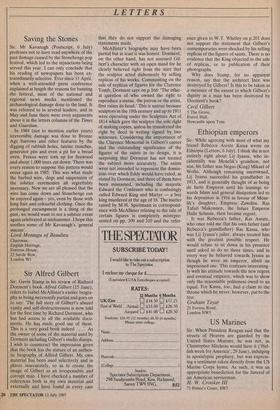Sir Alfred Gilbert
Sir: Gavin Stamp in his review of Richard Dorment's book Alfred Gilbert (15 June), refers to Isabel McAllister's earlier biogra- phy as being necessarily partial and goes on to say: 'The full story of Gilbert's absurd vanity and self-destructiveness is now told for the first time by Richard Dorment, who has had access to all the available docu- ments. He has made good use of them. This is a very good book indeed . .'. As the owner of some of the material used by Dorment including Gilbert's studio diaries, I wish to counteract the impression given that the book has the stature of an authen- tic biography of Alfred Gilbert. My own material has been used selectively and in places inaccurately, so as to create the image of Gilbert as an irresponsible and corrupt man. I have checked a number of references both in my own material and externally and have found in every case that they do not support the damaging statements made.
McAllister's biography may have been partial but at least it was honest. Dorment, on the other hand, has not assessed Gil- bert's character with an open mind for he clearly believed right from the start that the sculptor acted dishonestly by selling replicas of his works. Commenting on the sale of replicas of figures for the Clarence Tomb, Dorment says on p.168: 'The ethic- al question of who owned the right to reproduce a statue, the patron or the artist, first raises its head.' This is untrue because sculptors in the 19th century and up to 1911 were operating under the Sculpture Act of 1814 which gave the sculptor the sole right of making copies, unless he transferred the right by deed in writing signed by two witnesses. Considering the importance of the Clarence Memorial in Gilbert's career and the outstanding significance of the figures of the saints in its design, it is surprising that Dorment has not treated the subject more accurately. The saints were not intended to represent the domin- ions over which Eddy would have ruled, as stated by Dorment, and three of them have been misnamed, including the majestic Edward the Confessor who is confusingly called Edward King and Martyr — a boy king murdered at the age of 18. The matter raised by M.H. Spielmann in correspond- ence with McAllister relating to the sale of certain figures is completely misrepre- sented on pp. 309 and 310 and the refer- ence given to W.T. Whitley on p.201 does not support the statement that Gilbert's contemporaries were shocked by his selling replicas of the figures of saints. There is no evidence that the King objected to the sale of replicas, or to publication of their photographs.
Why does Stamp, for no apparent reason, say that the architect Ince was destroyed by Gilbert? Is this to be taken as a measure of the extent to which Gilbert's dignity as a man has been destroyed by Dorment's book?
Cecil Gilbert
5 The Grove, Forest Hall, Newcastle upon Tyne










































 Previous page
Previous page